5. Sub-Saharan Africa
Africa, which has rich natural resources and a population of 1.2 billion people, is drawing expectations and attention from the international community as the last enormous market in the world. Nonetheless, the region of Sub-Saharan Africa in particular, which lies south of the Sahara desert, still faces chronic poverty, economic disparities, lagging infrastructure development, low agricultural productivity, and shortage of industrial human resources. Furthermore, the continent is confronting new challenges in recent years, including the slowdown of the markets for commodities such as natural resources, the Ebola virus disease (EVD) outbreak, and frequent terrorist attacks. In response to these issues, the African Union (AU) Summit in January 2015 adopted the Agenda 2063 for the socio-economic transformation of Africa. In addition, in September 2015, the UN adopted new development goals named the 2030 Agenda. In this way, both Africa and the international community have launched new efforts towards development.
<Japan’s Efforts>
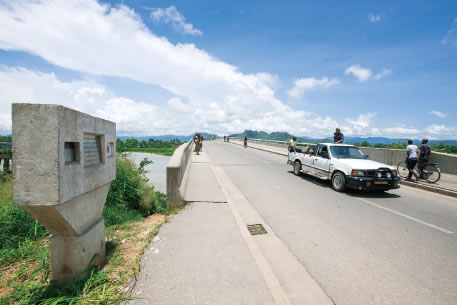
The Mangochi Road Bridge constructed with grant aid in Mangochi District in the southern region of Malawi. The bridge serves to invigorate the flow of goods through the Nacala Corridor. (Photo: Kenshiro Imamura / JICA)
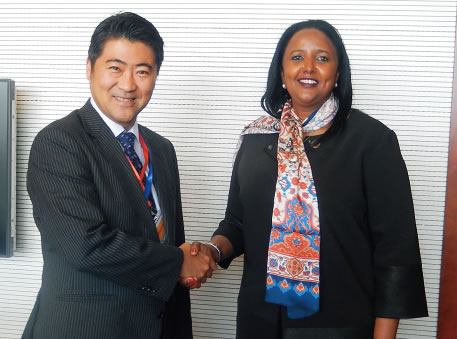
Then State Minister for Foreign Affairs Seiji Kihara talks with Ms. Amina C, Mohamed, Cabinet Secretary of Foreign Affairs and International Trade (As a result of organizational change in May 2016, she is currently Cabinet Secretary of Foreign Affairs) during his visit to Ethiopia for the 28th Ordinary Session of the Executive Council of the African Union in January 2016.
Given this context, Japan held TICAD VI together with the United Nations, the United Nations Development Programme (UNDP), the World Bank and the African Union Commission (AUC) in Nairobi, Kenya, on August 27 and 28, 2016. Including side events within the venue, over 11,000 people participated in TICAD VI, including the representatives of 53 African countries as well as development partner countries and Asian countries, international and regional organizations, the private sector, and civil society such as NGOs. In addition, a business mission with representatives from 77 organizations including Japanese businesses and universities accompanied Prime Minister Abe and introduced Japanese private-sector initiatives at each session.
At TICAD VI intensive discussions were held taking into account the changes in the environment surrounding African development since TICAD V held in 2013 (in particular the fall in international resources prices, the EVD epidemic, and the rise of terrorism and violent extremism). The themes of the discussions were (i) Promoting structural economic transformation through economic diversification and industrialization, (ii) Promoting resilient health systems for quality of life, and (iii) Promoting social stability for shared prosperity. As the outcome of these discussions, the Nairobi Declaration, which states the direction of African development, was issued.
The significance of TICAD VI is that private companies participated in all of the sessions for the first time, and the attendees agreed that the role of private companies is essential for Africa to sustain high economic growth and that the participants would actively boost the entry of companies, including Japanese companies, into Africa.
At TICAD VI, the Government of Japan announced that Japan would invest approximately $30 billion from the public and private sectors in total for the future of Africa, which includes human resources development to 10 million people (“Empowerment”), benefitting from the strength of Japan (“Quality”), and also developing quality infrastructure, promoting resilient health systems and laying the foundations for peace and stability, etc. for a period of three years from 2016 to 2018. Furthermore, since these efforts are the first step to achieve the outcomes of the G7 Ise-Shima Summit, Japan declared that it would steadily achieve the outcomes by utilizing its excellent science, technologies and innovation as the G7 chair country.
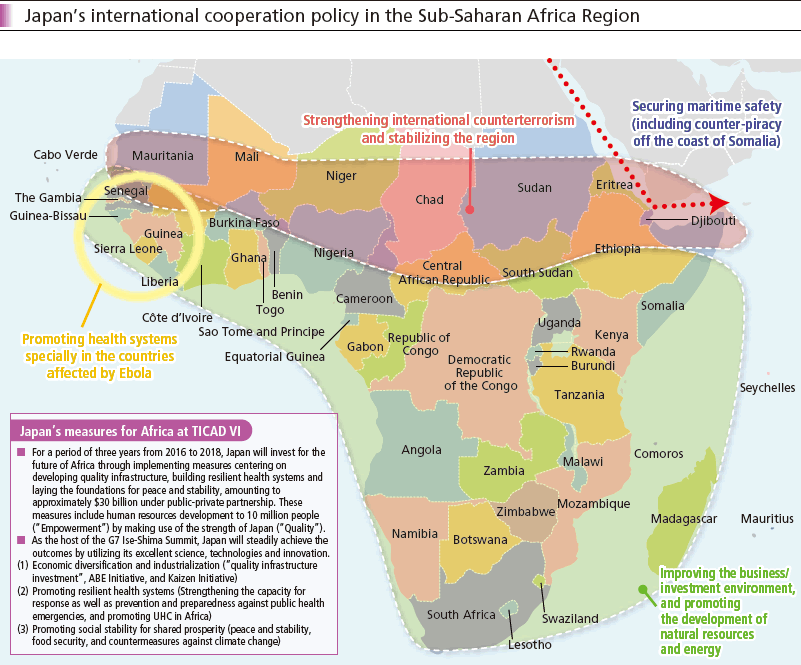

•Zambia
Technical Cooperation Project on Community-based Smallholder Irrigation (T-COBSI)
Technical cooperation project (March 1, 2013 – )
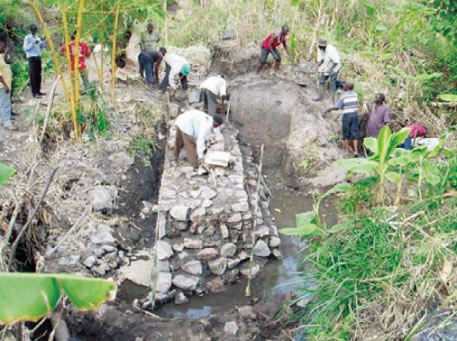
Weirs have been upgraded to masonry construction in the regions where irrigation farming with simple weirs is implemented successfully. (Photo: JICA)
In Zambia approximately 70% of the entire population is engaged in agriculture. The majority of those farmers are smallscale farmers who own less than one hectare of farm land. Most of the small-scale farmers have no access to irrigation facilities and are engaged in agriculture that depends on rainwater. They are extremely vulnerable to droughts and flooding, and Zambia repeatedly faced food shortages. The Government of Zambia announced a policy to increase the irrigated area for small-scale farmers in its National Irrigation Policy established in 2006 but it has not made sufficient progress due to funding constraints, etc.
In this situation, responding to the request from the Government of Zambia, the Government of Japan commenced the Technical Cooperation Project on Community-based Smallholder Irrigation (T-COBSI) for Northern province, Luapula province, and Muchinga province. It supports the introduction of irrigated agriculture utilizing small-scale irrigation facilities of farmerparticipation type. These provinces were chosen because they have a comparatively large amount of precipitation and differences of elevation in their river levels, so there is a high likelihood that gravity-fed irrigation facilities that distribute water by flowing the water from high places to low places can be introduced there.
Local irrigation engineers and agricultural promotion officers of the Ministry of Agriculture of Zambia who received training under this project actively took the lead in organizing the farmers and worked together with the farmers to construct weirs (simple weirs) using locally available natural materials such as wood, bamboo, clay, stone, etc. Moreover, in regions that have a track record of successful joint management of irrigation facilities due to the introduction of these simple weirs, pilot projects for weirs upgraded using rubble mortar masonry and concrete (permanent weirs) were implemented, encouraging the introduction of irrigation.
The respective irrigated areas are small at approximately one hectare, but through this project, 779 simple weirs and 14 permanent weirs have been constructed. The newlydeveloped small-scale irrigation area has reached 961 hectares, and the number of farmers receiving benefits from this has reached 13,745 people. Although the scale of each individual area is small, the project uses simple technology, and the introduction training is also implemented in stages, so the irrigated area is steadily increasing.
Furthermore, the introduction of small-scale irrigation has produced specific outcomes as the lives of the small-scale farmers improved. Specifically, their incomes increased due to the cultivation in the dry season, which enabled installation of solar panels, more payment of school fees and introduction of corrugated iron roofs on their houses. (As of August 2016)
•Malawi
Project for Strengthening of Mathematics and Science in Secondary Education in Malawi
Technical cooperation project (August 2013 – )
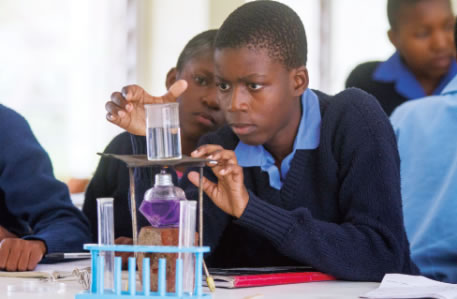
Students conducting an experiment in biology class (Photo: Shinichi Kuno / JICA)
Malawi, which is located in the southern part of Africa, made the primary education system (eight-year system) free of charge in 1994 to improve the low school enrollment rate. As a result, the number of students receiving primary education rapidly increased. The number of students receiving secondary education also rapidly increased from 50,000 (1994) to 260,000 (2010). However, the training of teachers could not keep pace with the increase in the number of students. Among 11,300 secondary school teachers, only 4,911 teachers (approximately 44%) had formal qualifications.
Therefore, in order to develop a system that can provide appropriate education in secondary education, improvement of the capabilities of “poorly-qualified teachers” and training for new qualified teachers are required. (“Poorly-qualified teachers” refers to unqualified teachers, teachers with teaching qualifications teach subjects outside the scope of their specialty, and teachers who do not meet the requirements of teaching capability — teachers who are supposed to teach at elementary schools teach at secondary schools.)
The National Education Sector Plan of Malawi stipulates the qualitative and quantitative enhancement of secondary education as a goal. For secondary education in particular, priority was placed on issues such as increasing the number of qualified teachers, adjusting class hours for teachers to an appropriate level, enhancing distance education courses to fully qualify poorly-qualified teachers, and improving the quality of teachers through in-service teacher training.
In order to tackle these issues, Japan implemented a project called “Strengthening of Mathematics and Science in Secondary Education” (SMASSE) from 2004 to 2007, and a project called “Strengthening of Mathematics and Science in Secondary Education Phase 2” (SMASSE Phase 2) from 2008 to 2012 in response to a request from Ministry of Education, Science and Technology of Malawi. These projects supported the creation of a system under which in-service teacher training to improve science and mathematics teaching methods can be implemented on a continuous basis nationwide.
The survey conducted at the end of SMASSE phase 2 confirmed the outcome of “system development” of human, organizational, and financial infrastructure enabling the provision of in-service teacher training on a continuous basis. Specifically, a total of four training sessions at the capital and three regional training sessions were implemented. With respect to the target of fostering 2,500 science and mathematics teachers, approximately 3,000 science and mathematics teachers were fostered, which is equivalent to about 30% of the total secondary teachers.
Meanwhile, in SMASSE Phase 2, the project started with mainly training the qualified teachers who were already in-service. Thus the training for teachers who only have elementary school teaching qualifications need to be implemented separately. And further improvements in the quality of the training contents are required.
In response to this situation, the Government of Malawi requested assistance from Japan for implementing “the Project for Strengthening of Mathematics and Science in Secondary Education in Malawi” in order to further disseminate and maintain the outcomes of SMASSE Phase 2. This project aims to further strengthen the capabilities of science and mathematics teachers and includes continuous implementation of in-service teacher training for 3,400 teachers, and the implementation of training in relation to practical teaching methods in new teacher training courses (before teaching internships) for the introduction of SMASSE training for 470 teachers in the training courses.
Through these Japanese initiatives, it is expected that the operational system for in-service teacher training will be strengthened and the teaching capabilities of science and mathematics teachers will improve, and as a consequence, the quality of science and mathematics classes in the secondary schools of Malawi will be improved. (As of August 2016)
